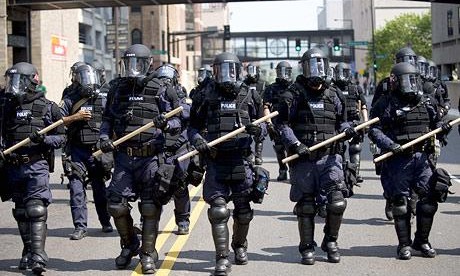Eyes Everywhere: Police Body Cameras

Since this article was drafted, the nation’s attention turned to yet another terrible tragedy in Baltimore. Many folks on the left and the right believe that these are just symptoms of a wider problem with police in America. One thing all these recent incidents have in common is that they were captured on cell phone cameras allowing them to come to wider attention. Here, Amanda Duckworth will examine the ways police body cameras, one policy response to this situation, may help more incidents come to attention and accountability. – Editors
What began as a routine traffic stop in North Charleston, S.C. quickly turned into a tragedy. On Saturday, April 4, police officer Michael Slager stopped a vehicle with a broken taillight, driven by Walter Scott. Mr. Scott fled the vehicle, likely fearing arrest over outstanding child-support payments, and ran towards a grassy lot with Officer Slager in pursuit. This sequence of events was later confirmed by video footage captured by the dashboard camera in Officer Slager’s patrol car. After this point, however, the narrative splits into two versions: the one reported by Officer Slager and the truth.
According to the North Charleston Police Department’s initial statement given on the day of the incident, Officer Slager deployed a department-issued Taser in an attempt to stop Mr. Scott, which did not work. The Department claimed that the men then struggled over the Taser and that Mr. Scott gained control of it and attempted to use it against Officer Slager. At this point, the Department said, Officer Slager resorted to his service weapon and shot Mr. Scott. Finally, the Police claimed that officers had tried to revive Mr. Scott prior to the arrival of paramedics, but he was pronounced dead at the scene. On Monday, April 6, Officer Slager released his own statement, through his attorney, stating his belief that he had properly followed all procedures and policies before resorting to deadly force and explaining that he had felt threatened.
This version of the story began circulating the media and likely would have gone unchallenged had it not been for a cell phone video of the shooting, which surfaced that Tuesday. The video, taken by a bystander, shows the men in the vacant lot right after Officer Slager fired his Taser. Wires from the Taser appear to be attached to Scott as he struggles with Slager and then turns to run. Something falls to the ground between the men and Officer Slager draws his gun and fires eight shots at the fleeing Scott, who is now 15–20 feet away. Scott falls to the ground and Slager approaches and handcuffs him. Slager then goes back to the location of the initial struggle, picks something off the ground, walks back to Scott’s body, and drops an object on the ground.
It is unclear when Officer Slager and the North Charleston Police Department first became aware of this video’s existence, but Slager was charged with murder on the day that it was posted and was fired. Since then, additional audio footage from the patrol car’s dashboard camera has been released, which captures conversations that happened after the shooting. In the recording, Slager is heard laughing about his pumping adrenaline immediately after the incident.
Video evidence obviously played an integral role in uncovering the truth in this incident, which follows other high-profile cases where police officers’ use of lethal force, particularly against black men, was called into question (such as the cases involving the deaths of Eric Garner and Michael Brown). The question becomes: should police officers be required to wear body cameras?
Support for this proposal has grown dramatically, especially in light of recent claims of police brutality and misconduct. In fact, a White House policing panel recommended that police departments put more video cameras on officers following the events in Ferguson, Missouri. Research on the effect of police wearing body cameras shows there is a dramatic drop in the use of force and citizen complaints when cameras are used. Further, research strongly supports the evidentiary value of body camera technology, which creates a permanent record of police-citizen encounters that is uniquely objective. This evidence can be used during investigations and at trial, thus mitigating the problems associated with a one-sided account of events (bias, self-interest, error, etc.).
While initial implementation costs may be high, body camera programs have the potential to facilitate greater judicial efficiency by thwarting police and citizen misconduct and offering faster resolution to conflicts that do occur. This means increased security for officers and the public alike, less frivolous complaints, and greater accountability for law enforcement.
The events surrounding Walter Scott’s death depict blatant failures in law enforcement, which almost went unnoticed. Fortunately, body camera technology can and should be used as a procedural safeguard against such behavior, rather than the occasional cell phone footage of a vigilant bystander.
